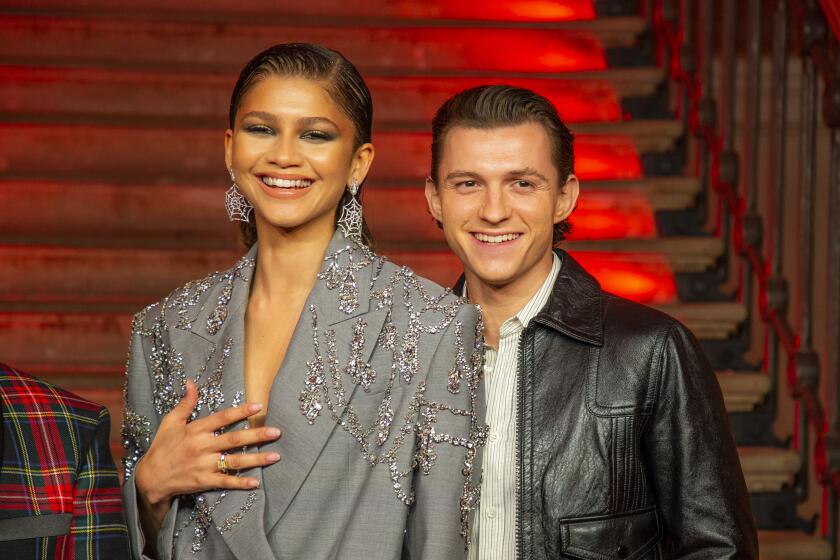Ancient book inspires classic animation of ‘The Secret of Kells’
As advances in technology allow for ever more realism in animated features, the artists behind “The Secret of Kells” -- the little-known Irish film that caught even insiders by surprise when it edged out the likes of “Ponyo” and “Cloudy With a Chance of Meatballs” for an Oscar nomination -- turned instead to the intricacies and grace of an ancient text to celebrate the curves and angles of traditional hand-drawn animation.
Using the scrollwork designs and microscopic detailing of the Book of Kells, an illuminated manuscript of the Four Gospels likely dating to the early 8th century, “The Secret of Kells,” which opens in L.A. on Friday, evokes the feel of Celtic tradition and a culture long past.
The idea for the film began incubating more than a decade ago when director/co-writer Tomm Moore was a student at Ballyfermot College in Dublin. “Richard Williams’ ‘The Thief and the Cobbler’ was a big inspiration, as were Genndy Tartakovsky’s TV programs and Disney’s ‘Mulan,’ ” Moore says. “We wanted to do something comparable with Irish art. A lot of Celtic design came from the Book of Kells, so we thought that was a good starting point.”
The film is set in the 8th century, when Viking raiders threatened to extinguish Irish monastic civilization. His parents killed in one such raid, 12-year-old novice Brendan lives within the walled monastery of Kells under the stern guardianship of his uncle, Abbot Cellach. When Brother Aidan arrives with the wondrously beautiful but unfinished book, Brendan realizes he wants to become an illuminator and help complete the manuscript that will be “a beacon in these dark times of the Northmen,” despite his uncle’s opposition.
“For a lot of us, Brendan is the kind of kid we were,” Moore says. “When you’re a kid trying to be an artist, you usually come up against the disapproval of your guardians.”
Defying the abbot’s orders, Brendan searches for the materials needed to make ink in the surrounding woods, where he meets Aisling, a silver-haired fairy who orders him out of “her” forest.
“A lot of the Christian stories from this time were very obviously adapted from earlier fairy tales,” Moore says. “Aisling became everyone’s favorite character because she represents that whole pantheon of fairy tales and pagan gods. We toyed with the idea of her becoming a love interest but it was more fun to make her a sort of pesky little sister.”
Brendan and Aisling are brought together by Brother Aidan’s cat, Pangur Ban. Its unusual name and the film’s central metaphor come from a poem by an 8th century monk, describing the nights he spends studying while his cat hunts mice. It concludes, “Practice every day has made / Pangur perfect in his trade; / I get wisdom day and night / Turning darkness into light.”
When Brendan fights the pagan god Crom Cruach, he steals the serpentine monster’s eye. Using it as a lens, Brendan is able to create intricate and dazzling images in the book. “There’s a story about St. Patrick defeating Crom -- it seems to be the source for St. Patrick driving the snakes out of Ireland,” Moore adds. “Prior to St. Patrick, Crom was defeated by the sun god, Lugh. So, in the pagan myth and the Christian parallel, we had the theme of turning darkness into light, as in the line from the poem. We decided to make Crom a snake who symbolizes Brendan’s fears: When Brendan steals Crom’s eye, he blinds his fear of becoming an artist.”
Art director Ross Stewart adapted the intricate style of the Book of Kells for the backgrounds. The woods where Brendan meets Aisling feel like an ancient forest, but the trees form complex spirals and knotted designs. The tendrils of mist, Aisling’s hair, the branches of the oaks and Pangur Ban’s tail all echo the same graceful curves. The resulting look is more stylized than any animated film American audiences have seen since Disney’s “Sleeping Beauty” in 1959.
But Moore realized it would be a mistake to use the same intricate style for the character designs. Detailed figures are hard to draw, and would get lost in the lush forest. “Having all that patterning and detail on each figure would just be crazy,” he says. “The characters could be simple but make complicated, pattern-like shapes when they’re grouped together. The individual characters are quite simple -- but they still have a medieval feel.”
Tartakovsky’s “Samurai Jack” showed that stylized characters should move in equally stylized ways. A character comprising flat, angular shapes, like Jack or Brendan, can’t move the way a rounded Disney figure does. Moore and his key group of artists worked out ways for Brendan, Aisling and Pangur Ban to move that harmonized with the film’s striking look.
Pete Docter, director of the Oscar-winning “Up,” notes that “ ‘Kells’ disproves the old dictum that the audience needs realism to connect with the characters.” He also says the film has much to teach others. “The Celtic designs work organically with the story being told. The film is a lesson in how graphic arts can influence film and introduce something new that couldn’t be done in any medium but animation.”
Moore’s next feature, “The Song of the Sea,” will focus on the last Silkie -- a little girl who can be both a human and a seal -- who serves as a bridge between modern Ireland and the fairy world.
Surely, after his Oscar nomination, studios and distributors are swarming to partner up on it?
“I’ve got enough money to make the storyboard,” Moore says. And after that “we’ll be putting in applications to the Irish Film Board and so on. We missed the deadline in February because we were in L.A. doing stuff for the Oscars -- a very happy interruption -- but we hope to go into production on ‘Song’ ” this year.”










